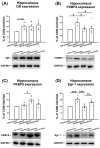Effects of RU486 in Treatment of Traumatic Stress-Induced Glucocorticoid Dysregulation and Fear-Related Abnormalities: Early versus Late Intervention
- PMID: 35628305
- PMCID: PMC9141845
- DOI: 10.3390/ijms23105494
Effects of RU486 in Treatment of Traumatic Stress-Induced Glucocorticoid Dysregulation and Fear-Related Abnormalities: Early versus Late Intervention
Abstract
Central glucocorticoid receptor (GR) activity is enhanced following traumatic events, playing a key role in the stress-related cognitive abnormalities of posttraumatic stress disorder (PTSD). GR antagonists are expected to have potential as pharmacological agents to treat PTSD-related symptoms such as anxiety and fear memory disruption. However, an incubation period is usually required and stress-induced abnormalities do not develop immediately following the trauma; thus, the optimal intervention timing should be considered. Single prolonged stress (SPS) was employed as a rodent PTSD model to examine the effects of early or late (1-7 versus 8-14 days after the SPS) sub-chronic RU486 (a GR antagonist) administration. Behaviorally, fear conditioning and anxiety behavior were assessed using the fear-conditioning test and elevated T-maze (ETM), respectively. Neurochemically, the expressions of GR, FK506-binding proteins 4 and 5 (FKBP4 and FKBP5), and early growth response-1 (Egr-1) were assessed in the hippocampus, medial prefrontal cortex (mPFC), amygdala, and hypothalamus, together with the level of plasma corticosterone. Early RU486 administration could inhibit SPS-induced behavioral abnormalities and glucocorticoid system dysregulation by reversing the SPS-induced fear extinction deficit, and preventing SPS-reduced plasma corticosterone levels and SPS-induced Egr-1 overexpression in the hippocampus. Early RU486 administration following SPS also increased the FKBP5 level in the hippocampus and hypothalamus. Finally, both early and late RU486 administration inhibited the elevated hippocampal FKBP4 level and hypothalamus GR level in the SPS rats. Early intervention with a GR antagonist aids in the correction of traumatic stress-induced fear and anxiety dysregulation.
Keywords: anxiety; fear memory; glucocorticoid receptor; hippocampus; posttraumatic stress disorder; time-dependent effect.
Conflict of interest statement
The authors declare that they have no known competing financial interests or personal relationships that could have appeared to influence the work reported in this paper.
Figures







Similar articles
-
Effects of early life social experience on fear extinction and related glucocorticoid profiles - behavioral and neurochemical approaches in a rat model of PTSD.Behav Brain Res. 2020 Aug 5;391:112686. doi: 10.1016/j.bbr.2020.112686. Epub 2020 May 16. Behav Brain Res. 2020. PMID: 32428628
-
Hyperbaric oxygen therapy restored traumatic stress-induced dysregulation of fear memory and related neurochemical abnormalities.Behav Brain Res. 2019 Feb 1;359:861-870. doi: 10.1016/j.bbr.2018.07.014. Epub 2018 Jul 26. Behav Brain Res. 2019. PMID: 30056129
-
Late glucocorticoid receptor antagonism changes the outcome of adult life stress.Psychoneuroendocrinology. 2019 Sep;107:169-178. doi: 10.1016/j.psyneuen.2019.05.014. Epub 2019 May 16. Psychoneuroendocrinology. 2019. PMID: 31132569
-
Single prolonged stress: toward an animal model of posttraumatic stress disorder.Depress Anxiety. 2009;26(12):1110-7. doi: 10.1002/da.20629. Depress Anxiety. 2009. PMID: 19918929 Review.
-
Early-life stress impairs acquisition and retrieval of fear memories: sex-effects, corticosterone modulation, and partial prevention by targeting glucocorticoid receptors at adolescent age.Neurobiol Stress. 2024 Apr 23;31:100636. doi: 10.1016/j.ynstr.2024.100636. eCollection 2024 Jul. Neurobiol Stress. 2024. PMID: 38883213 Free PMC article. Review.
Cited by
-
Effects of a True Prophylactic Treatment on Hippocampal and Amygdala Synaptic Plasticity and Gene Expression in a Rodent Chronic Stress Model of Social Defeat.Int J Mol Sci. 2023 Jul 7;24(13):11193. doi: 10.3390/ijms241311193. Int J Mol Sci. 2023. PMID: 37446371 Free PMC article.
-
Mitochondrial Impairment: A Common Motif in Neuropsychiatric Presentation? The Link to the Tryptophan-Kynurenine Metabolic System.Cells. 2022 Aug 21;11(16):2607. doi: 10.3390/cells11162607. Cells. 2022. PMID: 36010683 Free PMC article. Review.
-
Diosgenin normalization of disrupted behavioral and central neurochemical activity after single prolonged stress.Front Pharmacol. 2023 Aug 16;14:1232088. doi: 10.3389/fphar.2023.1232088. eCollection 2023. Front Pharmacol. 2023. PMID: 37663254 Free PMC article.
-
Basal forebrain cholinergic systems as circuits through which traumatic stress disrupts emotional memory regulation.Neurosci Biobehav Rev. 2024 Apr;159:105569. doi: 10.1016/j.neubiorev.2024.105569. Epub 2024 Feb 1. Neurosci Biobehav Rev. 2024. PMID: 38309497 Free PMC article. Review.
-
Glucocorticoids modulate neural activity via a rapid non-genomic effect on Kv2.2 channels in the central nervous system.Neurobiol Stress. 2023 Nov 25;28:100593. doi: 10.1016/j.ynstr.2023.100593. eCollection 2024 Jan. Neurobiol Stress. 2023. PMID: 38075025 Free PMC article.
References
-
- Jonas D.E., Cusack K., Forneris C.A., Wilkins T.M., Sonis J., Middleton J.C., Feltner C., Meredith D., Cavanaugh J., Brownley K.A., et al. Psychological and Pharmacological Treatments for Adults With Posttraumatic Stress Disorder (PTSD) Agency for Healthcare Research and Quality; Rockville, MD, USA: 2013. - PubMed
-
- Diagnostic and Statistical Manual of Mental Disorders (DSM-5) 5th ed. American Psychiatric Publishing, Inc., American Psychiatric Association; Washington, DC, USA: 2013.
MeSH terms
Substances
Grants and funding
- 105-2410-H-016-002-MY2/Ministry of Science and Technology
- 107-2410-H-350-001/Ministry of Science and Technology
- 108-2623-E-350-001-D/Ministry of Science and Technology
- 108-2410-H-350-001-MY2/Ministry of Science and Technology
- MAB-107-051/National Defense Medical Center
- MAB-108-062/National Defense Medical Center
- MAB-109-052/National Defense Medical Center
- MND-MAB-110-078/National Defense Medical Center
- CH-NDMC-108-9/Cheng Hsin General Hospital and National Defense Medical Center
- CH-NDMC-109-7/Cheng Hsin General Hospital and National Defense Medical Center
- CH-NDMC-110-9/Cheng Hsin General Hospital and National Defense Medical Center
- 805-C107-06/Hualien Armed Forces General Hospital
- 805-C108-18/Hualien Armed Forces General Hospital
- HAFGH-E-109016/Hualien Armed Forces General Hospital
- HAFGH-D-110011/Hualien Armed Forces General Hospital
- TSGH-C106-107/Tri-Service General Hospital
LinkOut - more resources
Full Text Sources
Other Literature Sources
Miscellaneous

